|
"Scaling" The Matterhorn Region
 In the heart of the Swiss Alps, the beautiful Matterhorn Region is a little over 90 miles long. Close to 50 mountain peaks surround the Rhone River
valley, and the fertile grounds are home to Swiss wine and fruit growers. It is obvious why this region is the highlight of many vacationers in Switzerland. The famous peak and the unique world of glaciers and
mountains surrounding the valley by the same name truly steal the show. The prime destination here in the southwestern part of the country is the village of Zermatt, which lies in the Matter Valley at the center
of the scenic amphitheatre of glaciers and mountains. In the heart of the Swiss Alps, the beautiful Matterhorn Region is a little over 90 miles long. Close to 50 mountain peaks surround the Rhone River
valley, and the fertile grounds are home to Swiss wine and fruit growers. It is obvious why this region is the highlight of many vacationers in Switzerland. The famous peak and the unique world of glaciers and
mountains surrounding the valley by the same name truly steal the show. The prime destination here in the southwestern part of the country is the village of Zermatt, which lies in the Matter Valley at the center
of the scenic amphitheatre of glaciers and mountains.In Zermatt, the impressive snow-capped Matterhorn at 14,680 feet easily towers over the artistically-attractive
village and all other 38 mountain peaks around. Just as the Liberty Statue is synonymous with New York, the Matterhorn is synonymous with Switzerland. Even better, cars are not allowed in Zermatt. Some
hotels offer small electric buses for luggage and for guests with walking disabilities; horse-drawn carriages are also used for some inner-village transportation. All vehicle traffic must park several
miles away and take the train into the village. One tip for those that drive is that you can get unlimited free parking at the Visp train station. For information on the car-free village of Zermatt, check out
http://www.zermatt.ch/matterhorn-group. After arriving in Zermatt, we settled into the very comfortable 84-room Zermatterhof Hotel. The five star historic
property was opened in 1879 and was one of the first hotels in the village. Fortunately, the local community has made certain that the small, quaint village retains its personality and culture as new construction
continues in this popular destination. This doesn't prevent hotels like the Zermatterhoff from offering the most modern accommodations, including internet access. Just a 5-minute walk from the train station, the hotel's
central location is ideal. For information on the Zermatterhof hotel, visit http://www.matterhorn-group.ch/en/zermatterhof/hotel/index.php.
Today, there are over 100 small hotels and over 100 restaurants in Zermatt to sleep and feed those international visitors that hit the mountains during the daylight. For Zermatt hotel options and availability, click here.
Several of the innumerable hiking paths that traverse the valley can be accessed within a few minutes walk from most of the village's hotels. From easy walking to mountain biking to extreme hiking, spending time
in the Matter Valley outdoors is a "must do" for any visitor. In the winter, there is skiing, snowboarding, snow tubing, snow cross and snow cart among other sport activities. In warmer weather, there's canyoning,
mudbiking and other exercising means of sport.
Six drag-lifts and a cable-car give access to guaranteed snow year around and the highest summer ski area
in the Alps. Four breathtaking peaks are accessible by either cog-wheel train or cable car. The 3-day Peak Pass, at approximately $150 per person, is the best way to have unlimited access to all the viewpoints. The
 ride to Rothorn is first by cog-wheel and then by
cable car on up to 7,500 feet elevation. The middle station on your way to Rothorn is called Sunnegga, which means "sunny corner". A gondola holding up to four people then takes you
from Sunnegga up to Blauherd and its picnic facilities at 8,490 feet in 7 minutes. From there, a panoramic cable car takes you up to the 10,170-foot-tall Rothorn, which offers the most
photogenic side of the Matterhorn. ride to Rothorn is first by cog-wheel and then by
cable car on up to 7,500 feet elevation. The middle station on your way to Rothorn is called Sunnegga, which means "sunny corner". A gondola holding up to four people then takes you
from Sunnegga up to Blauherd and its picnic facilities at 8,490 feet in 7 minutes. From there, a panoramic cable car takes you up to the 10,170-foot-tall Rothorn, which offers the most
photogenic side of the Matterhorn. For those who don't like to dangle from a cable, the first stage to the Gornergrat mountain peak can be visited only by cog-wheel train, offering
fantastic views and a restaurant at the top for lunch. Recent expansion of this scenic route now includes a cable car to the highest point at Stockhorn, which is at 11,170 feet.
The Matterhorn Express is the newest cable car, taking only 12 minutes to Schwarzsee to reach 8,470 feet and the foot of the majestic Matterhorn. This spot offers the closest view of the Matterhorn
and the starting point for climbing the impressive peak. A mountain lake reflects a small chapel and the beautiful mountain scenery. From here, a 3-hour hike back to the village passes below the
north face of the Matterhorn and offers some of the most beautiful scenery in the area.
 But the highlight for soft adventure seekers is the Matterhorn
Glacier and a 40-minute scenic cable car ride in three stages. The first gondola with 8 seats takes you up to the first station called Furi. A cableway for 120 people continues to station
Trockener Steg, the final stopping point for many people due to the altitude and thin air. The final ride on the highest cable car in the world reaches the Klein Matterhorn at 12,710 feet
where the thin air dictates that some visitors walk around the area slowly in order to avoid becoming light headed. But the highlight for soft adventure seekers is the Matterhorn
Glacier and a 40-minute scenic cable car ride in three stages. The first gondola with 8 seats takes you up to the first station called Furi. A cableway for 120 people continues to station
Trockener Steg, the final stopping point for many people due to the altitude and thin air. The final ride on the highest cable car in the world reaches the Klein Matterhorn at 12,710 feet
where the thin air dictates that some visitors walk around the area slowly in order to avoid becoming light headed. Once at the station, visitors can take an elevator and climb
stairs to the 250-foot high platform on top that allows the best view of the world class, panoramic spread of mountains, glaciers and permanent snow. It is here on Europe's highest
viewing platform where you can see the Italian and French Alps in the distance, as well as half a dozen glaciers and indescribable scenery of the Swiss Alps. At a nearby
mountain top, we could see many hikers utilizing a rope for safety continuing their ascent towards the top of the Little Matterhorn. During skiing season, newcomers often
inadvertently end up in Italy, since many of the skiing trails at the top of the mountain are shared by both countries.
 An interesting ice pavilion is carved into the
glacier on top of this mountain. An icy footpath and a handy rope help to navigate the downward trail into the "ice grotto" some 50 feet below the surface. The narrow path suddenly opens into a massive ice cave
where smaller caves are carved out. Many had interesting displays of ice sculptures to view. As is common in Switzerland, a free wine offering at the "grotto bar" is included during the visit to the glacier cave. An interesting ice pavilion is carved into the
glacier on top of this mountain. An icy footpath and a handy rope help to navigate the downward trail into the "ice grotto" some 50 feet below the surface. The narrow path suddenly opens into a massive ice cave
where smaller caves are carved out. Many had interesting displays of ice sculptures to view. As is common in Switzerland, a free wine offering at the "grotto bar" is included during the visit to the glacier cave.
After reaching the peak and enjoying the memorable views, we headed back down to the Furi station where we had lunch on an outdoor veranda
overlooking the Matterhorn and mountain scenery. We enjoyed viewing the cable cars on their way up and down the mountain while we feasted on a lunch of Rossti and eggs (eggs with sausage and hash browns).
With a full stomach, we decided to take an easy, 45-minute long walking trail down the mountain to Zermatt. This was by far the best way of getting an upfront and close experience of the wonderful scenery and the
beautiful quiet of the countryside. In one area, cows with their neck bells softly ringing grazed in a small pasture. It was such a relaxing
moment to embrace! The path took us through many small vintage cottages (called mazots) used for drying meat. We learned that the large round shale stone "guards" at the corner pilings of each building were in
place to prevent mice from climbing into the structures. The original buildings also have shale roofs which easily withstand the heavy snows. Even some of the modern buildings in the area have shale roofs.
Evenings in the village of Zermatt can be as enchanting as the daytime activities are exciting. World-famous
musicians schedule concerts at the Reffelalp Chapel in late summer. During our visit, we were invited to listen to Emmanuel Pahud, the solo flautist from the Berliner Philharmonic Orchestra. It was truly a magical
experience listening to the live small chamber orchestra, in a several hundred year old chapel that is now surrounded by a community of hotels, chalets, apartments, shops, restaurants and other mountain
structures. We could have just as easily been listening to the flautist at any major concert hall in the world. While the beauty of the mountains enchants the eyes, the music enchanted the spirit.
Swiss Pass
Eurailpass: flexible travel throughout 17 countries
Back to Table of Contents
Next Article - Express Routes |
